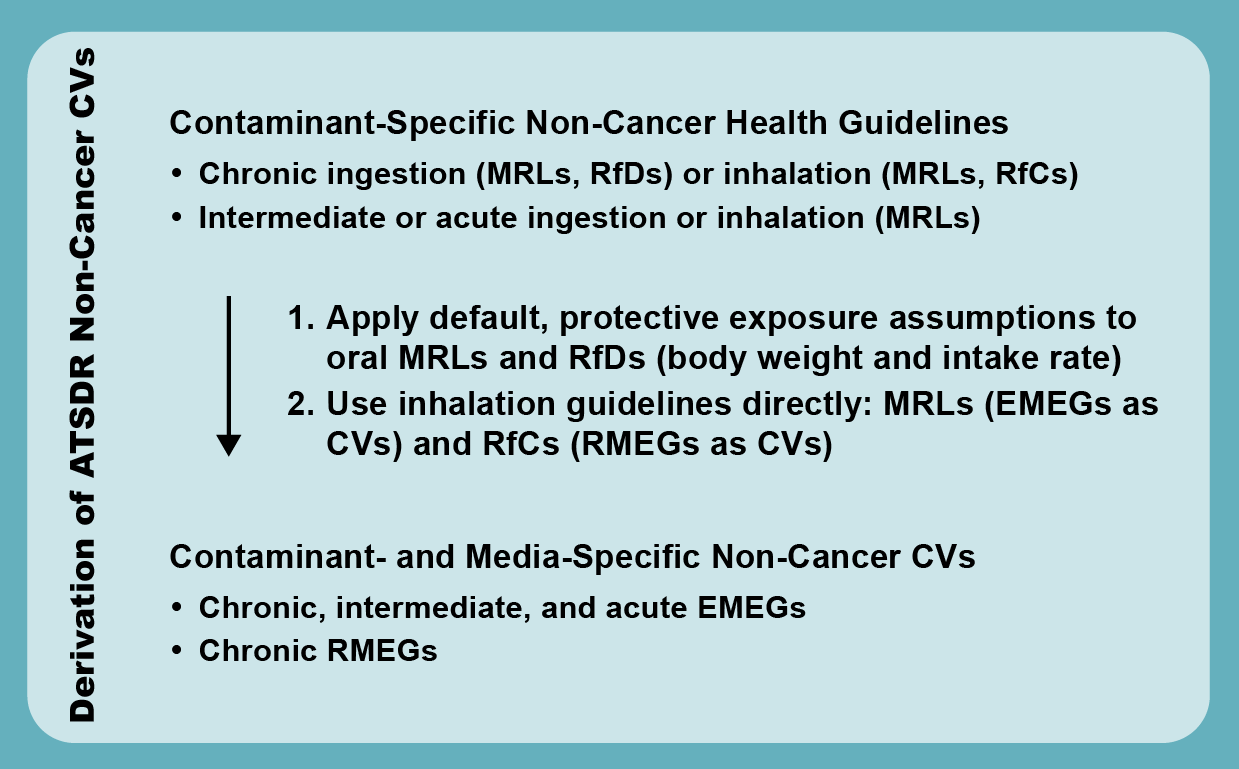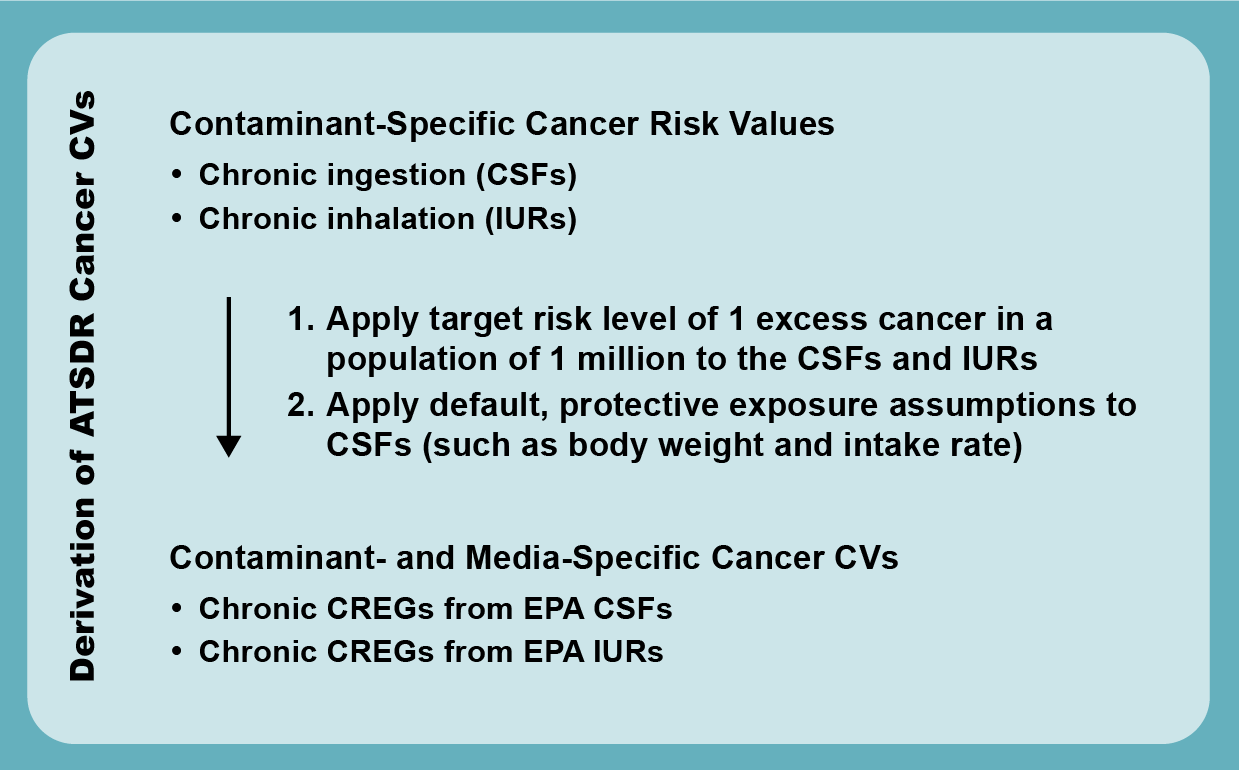Screening Levels Used by ATSDR
This section explains the screening levels health assessors can use during the screening analysis. It explains how ATSDR derives its own screening levels, called comparison values (CVs), and when to use non-ATSDR screening levels.
The screening analysis involves comparing detected maximum contaminant concentrations (except for some air evaluations) to screening levels, which represent concentrations of a particular contaminant in a specific medium. To start the screening analysis, health assessors identify whether medium-specific screening levels are available for contaminants in their data sets. Screening levels fall into two categories:
- ATSDR comparison values (CVs) are screening levels developed by the agency. If available, the CV must be used.
- Non-ATSDR screening levels. These can be used in addition to ATSDR CVs, when ATSDR CVs are not available, or when lower (i.e., more health protective) than ATSDR CVs.
ATSDR has this process diagram to help health assessors identify appropriate ATSDR CVs and/or non-ATSDR screening levels. When several ATSDR CVs are available for a contaminant in a particular medium, health assessors usually use the lowest available CV (the most health protective) to identify potential contaminants of concern. When using PHAST, the application will flag the recommended CV to use for each contaminant. The process for selecting ATSDR CVs and non-ATSDR screening levels is described in detail in Step 3: Select Appropriate Screening Levels.
CVs are contaminant concentrations in a particular medium, such as air, soil, or water, to which humans might be exposed without the likelihood of experiencing harmful health effects. Each CV is specific to a particular contaminant and environmental medium. CVs help health assessors make consistent decisions about what contaminant concentrations associated with site exposures might require a closer look.
After completing a screening analysis, you will have divided contaminants identified at the site into two categories:
- Contaminants requiring no further analysis (below established screening levels).
- Contaminants requiring further evaluation because they meet or exceed established screening levels, have no screening levels available, or represent a contaminant of concern (e.g., a community concern).
ATSDR develops non-cancer and cancer CVs using appropriate noncancer health guidelines and cancer risk values, respectively, as well as standard default exposure assumptions. Health guidelines consist of oral doses and air concentrations developed from toxicology or epidemiology studies (with safety factors applied) that are protective of human health.
Note: While ATSDR’s CVs are always contaminant concentrations in a specific medium, ATSDR’s health guidelines are generally doses. For inhalation, however, the ATSDR CV is the same as the health guideline and is a concentration in air.
Health guidelines are the basis for non-cancer CVs. This table lists the most common health guidelines used by ATSDR to derive non-cancer CVs.
Cancer risk values, which serve as the basis for ATSDR’s cancer CVs, represent estimates of possible increases in cancer cases in a human population from exposure to the specific contaminant concentration through a particular exposure route. This table lists the most common cancer risk values ATSDR uses to derive cancer CVs.
It’s important to understand what CVs represent to use them appropriately and clearly communicate their role in the PHA process. CVs enable you to identify contaminants that either are not expected to result in harmful health effects (i.e., contaminants detected below CVs) or that require further evaluation (i.e., contaminants detected at or above CVs).
CVs are not thresholds of toxicity. CVs should not be used to predict harmful health effects. CVs are based on a default exposure scenario and do not reflect site-specific exposures. These values serve only as guides to provide an initial screen of human exposure to contaminants.
Although concentrations below the relevant CVs can reasonably be considered safe, you cannot assume that any environmental concentration that meets or exceeds a CV would produce harmful health effects.
Health Guidelines |
Definition |
|---|---|
| ATSDR-Developed Minimal Risk Levels (MRLs) |
|
| EPA-Derived Reference Doses (RfDs) |
|
| EPA-Derived Reference Concentrations (RfCs) |
|
EPA-Derived Cancer Risk Values |
Definition |
|---|---|
| Oral Cancer Slope Factors (CSFs) |
|
| Inhalation Unit Risks (IURs) |
|
ATSDR develops its CVs for contaminants that have adequate toxicity data available. ATSDR uses default exposure assumptions, health guidelines, and cancer risk values to derive CVs to protect the health of children and adults.
Default exposure assumptions generally represent high estimates of exposure based on observed ranges of human activity patterns (like water ingestion rates). For example, ATSDR uses Reasonable Maximum Exposure (RME) intake rates for CV development, which refers to people who are at the high end of the exposure distribution (approximately the 95th percentile), a scenario intended to assess exposures that are higher than average, but still within a realistic exposure range.
Default exposure assumptions are provided in ATSDR’s Exposure Dose Guidance (EDG) documents. Health assessors can access these documents in the PHAGM Resources section.
ATSDR develops its CVs assuming that exposures occur through contact to a single medium and to a single contaminant for a specified exposure period: acute (14 days or less), intermediate (15 to 364 days), or chronic (365 days and longer).
For more information, refer to ATSDR’s CV Supplemental Guidance that presents the exposure assumptions, CV formulas, and other information related to how ATSDR develops each of its CVs.
Types of ATSDR-Derived CVs
ATSDR develops CVs for both non-cancer health effects (see figure) and cancer effects (see figure). When developing non-cancer CVs, ATSDR assumes that only non-cancer health effects will occur, and when developing cancer CVs, ATSDR assumes that only cancer health effects will occur. When a contaminant has both a cancer and non-cancer CV, health assessors use the lowest of the two CVs for screening.
ATSDR’s Non-Cancer CVs
For non-cancer health effects, ATSDR has developed environmental media evaluation guides (EMEGs) and reference dose media evaluation guides (RMEGs) (see table). ATSDR uses EMEGs and RMEGs to screen contaminant concentrations in different media, such as soil and water. CVs are derived differently, depending on the type of media.
ATSDR-Derived CVs |
Definition |
|---|---|
| EMEGs |
Air EMEGs:
Drinking Water EMEGs:
Soil EMEGs:
|
| RMEGs |
Air RMEGs:
Drinking Water RMEGs:
Soil RMEGs:
|

Notes:
CV = comparison value
EMEG = environmental media evaluation guide
MRL = minimal risk level
RfC = reference concentration
RfD = reference dose
RMEG = reference dose media evaluation guide
ATSDR’s Cancer CVs
For cancer effects, ATSDR has developed cancer risk evaluation guides (CREGs) (see table) to identify estimated concentrations of cancer-causing contaminants that would be predicted to cause no more than one excess cancer in a million persons exposed during their lifetime (78 years). CREGs for some media, like water and soil, are derived using EPA’s oral CSFs and default exposure assumptions. CREGs for air are derived using EPA’s IURs.
ATSDR-Derived CVs |
Definition |
|---|---|
| CREGs |
|

Notes:
CREG = cancer risk evaluation guide
CV = comparison value
CSF = oral cancer slope factor
IUR = inhalation unit risk
Health assessors might use non-ATSDR screening levels in certain situations, such as the following:
- No ATSDR-derived CV is available for a particular contaminant in a specific medium at a site. While ATSDR has developed CVs for many of the most common contaminants found at Superfund sites, you might find some contaminants for which ATSDR CVs are not available.
- No ATSDR-derived CV is available for some specific media.
- The non-ATSDR screening level is adequately protective of public health and lower than ATSDR’s recommended CV for the same exposure duration. For instance, the state in which a site is located has its own health-based screening levels. In cases like this, after you have approval from the Associate Director for Science (ADS) to use a non-ATSDR screening level, you can use the lower level. In your document, discuss all of the screening levels you used in your evaluation.
There are various types of non-ATSDR screening levels. This table provides a list of some. Note that ATSDR does not endorse the use of any non-ATSDR screening level, but this list includes sources suggested by health assessors for various types of non-ATSDR screening levels. Many available non-ATSDR screening levels are based on health effects observed in scientific human or animal studies, but others are not completely health-based. Before using them in your screening analysis, ensure you understand how the non-ATSDR screening levels were derived and discuss their possible use with the Associate Director for Science (ADS) group (see text box below).
Because the mandates of different agencies may not always be strictly health-driven or consistent with the concerns of sites ATSDR works on, it is important to fully understand the derivation, uncertainties, and possible limitations of a non-ATSDR screening level. Be sure a screening level is adequately protective of public health before using it in your screening analysis.
For example, some screening levels are derived based on environmental effects rather than human health concerns. Selecting such screening levels would not necessarily aid in evaluating public health concerns.
Before using a screening level from another source in your screening analysis, always confirm that it is appropriate. Consult with a subject matter expert (SME), a toxicologist, or the Associate Director for Science (ADS) group.